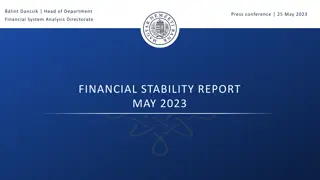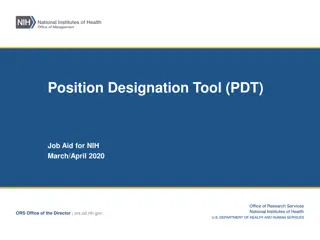Market Position Statement
Nottingham City Council's Market Position Statement for Adult Social Care outlines strategies and initiatives aimed at improving the lives and outcomes of older and disabled citizens. Focusing on prevention, early intervention, and community connections, the council aims to enable individuals to live independently and access the support they need. The document emphasizes the importance of building sustainable care models and fostering partnerships to meet evolving needs in Nottingham.
Download Presentation

Please find below an Image/Link to download the presentation.
The content on the website is provided AS IS for your information and personal use only. It may not be sold, licensed, or shared on other websites without obtaining consent from the author. Download presentation by click this link. If you encounter any issues during the download, it is possible that the publisher has removed the file from their server.
E N D
Presentation Transcript
Market Position Statement For Adult Social Care in Nottingham City
Introduction Better Lives Better Outcomes.............................3 Prevention and early intervention......................4 Key components of commissioning activity........5 Nottingham key facts..........................................6 Nottingham context: current position.................7 Future age demographic and needs 18 64 years..............................................................9-11 Future age demographic and needs 65 years and over..............................................................13-15 Breakdown of primary support needs...............17 Workforce key facts...........................................19 Overview of services and key messages to the market..........................................................20-29 Market Position Statement engagement plan...30 Appendices........................................................31 This Market Position Statement is an important part of our relationship with the market, and aims to: build on local strategies and vision for the future of Nottingham City. outline the new approaches and services that are needed. encourage partners to shape a sustainable model of care. achieve better health and wellbeing outcomes. The objective of this Market Position Statement is to outline our understanding of the current market for adult services and to identify future demand for services, and to initiate meaningful discussions between the Council and providers of services to ensure that we can meet local need. This Market Position Statement provides an overview of the demographic make-up of Nottingham and the changing needs we are responding to now and in the future. It also sets out opportunities for providers, partners and stakeholders to help to develop services to meet needs and demand. Nottingham City Council is working towards significant change in the way adult social care services are delivered. Local people s expectations have changed, new models of service delivery are under review or being developed and there are opportunities to harness new technologies, with an increased focus on prevention and ensuring outcomes for citizens are the best they can be.
Better Lives Better Outcomes Better Lives Better Outcomes is Nottingham City Council s Adult Social Care strategy and sets out how care and support are provided for older and disabled people in the city. Strategic Vision: Strategic Vision: We will enable all older and disabled citizens, including those with mental health needs,in Nottingham to live as independently as they can, with a connection to their communities. When formal care and support is needed, its aim will be to retain and restore independence.No one will live in residential care unless all other options are exhausted. To achieve this vision we need to: Support people to do what they can for themselves Help friends and families to provide the best possible support for each other Provide connections to others who can help from within Nottingham s caring communities The four themes in the strategy that will underpin our approach are prevention, community connections, independent lives and choice and control. connections, independent lives and choice and control. These themes reflect principles set out in the Care Act 2014. prevention, community For links to associated Council strategies, please see Appendix 1
Prevention and early intervention Nottingham needs a sustainable social care system to help people live better lives. Prevention remains at the heart of the Council's approach to adult social care provision. This is underpinned by acting to prevent, reduce or delay the need for care and support. In order for us to achieve a sustainable system, we will maintain the focus on prevention and early intervention across all services. The diagram below illustrates this shift where all of our interventions will be enabling in nature. Enabling people to live their lives fully and as independently as possible, providing appropriate person-focussed support at the right time Shifting overall use of resources over time towards prevention or community-based support maximising impact and best value More prevention and early intervention More community-based, personalised support Less reliance on traditional care Increased impact of information and advice Resilient home-based and community-based care Reduced placement breakdowns Expanded use of voluntary and community sector Reablement Cost-effective in-house services Joint health and social care personal budgets Evidence-based early intervention Proactive management of market capacity and innovation Greater accessibility of community assets Increasing use of Individual Service Funds Reduced overall residential usage Underpinned by: co-production and community engagement; strategic system integration; collaborative working with providers and partners; strong insight and evidence bases; proactive market shaping and development; robust assurance of quality and value; a sustainable and sufficient community care workforce; demand and market cost modelling; innovation and creativity to positively disrupt traditional commissioning approaches and ways of working.
Key components of commissioning activity All councils have a statutory duty to deliver Best Value. We will be embedding Best Value across the council to ensure outcomes for citizens are delivered efficiently and effectively. The key components of Best Value which we will be embedding into commissioning activities are shown below. Best Value Component Definition These are core components of Best Value: Efficiency Getting the greatest outputs from financial inputs Economy Getting the right inputs and quality standards at an appropriate cost. Social value involves maximizing the additional environmental, social and economic benefit that can be created by procuring or commissioning goods and services, above and beyond the benefit of merely the goods and services themselves. Efficiency and Economy Social Value Early Early intervention services will be promoted, this will include activity aimed at halting the development of a problem which is already evident, preventing problem development, and bringing the right health and social care skills at the right time to support residents proactively. Intervention/ Prevention An outcomes focus means delivering meaningful and valued impact or change through a commissioned activity or set of activities. Commissioned services should focus, for example, on improving resident wellbeing and independence, delivering resident satisfaction or safety. Effectiveness in delivering Benefits/Outcomes Co-production Citizens are experts in their own lives, and will be involved in designing and shaping service development.
Nottingham Context Current position Key Facts: Key Facts: Ethnicity Ethnicity - - Key Facts: Key Facts: Population: Nottingham has a relatively young population Nottingham has a relatively young population The 2021 census shows that in the last 10 years the proportion of people from Black, Asian and minority ethnicities in Nottingham has increased from 35% to 42.7% Nottingham City had a population of 323,700 people in 2021, with 219,700 aged between 18-64 (67.8%) and 38,000 38,000 aged 65 and over (11.6%). 42.7% of the total population. The largest non-White British groups are Other White (7.4%), Asian Pakistani (6.7%) and Black African (5.8%). These groups have all increased in their proportion of the total population of the city since 2011. Disability: 1/3 of Nottingham households contain a person who is disabled 1/3 of Nottingham households contain a person who is disabled 26,527 people in Nottingham are disabled under the Equality Act and their day-to-day activities are limited a lot, a decrease of 1,172 (-4.2%) since 2011. This means that there will need to be a significant focus on ensuring that The Council, its partners This means that there will need to be a significant focus on ensuring that The Council, its partners and the provider market are delivering equitable social care support services to all minority ethnic and the provider market are delivering equitable social care support services to all minority ethnic groups and populations within Nottingham. groups and populations within Nottingham. 35.9% of households contain one or more people disabled under the Equality Act A further 18,600 people are not disabled under the Equality Act but have a long term physical or mental health condition - but day-to-day activities are not limited Health and Wellbeing: Asian citizens are 43% less likely than white citizens to be diagnosed with severe mental illness Mixed race citizens are 1.4x more likely than white citizens to be diagnosed with severe mental illness Asian and Black citizens are 35-40% less likely than white patients to receive Primary Care Deprivation: Nottingham has high levels of deprivation Nottingham has high levels of deprivation Nottingham is ranked 11th most deprived district in England in the 2019 Index of Multiple Deprivation (IMD). Life expectancy is currently ranked 138th and 134th out of all the local authorities in England, for men and for women suggesting that individuals in the city may transition into poor health at an earlier point in their lives and may require support from the Council sooner in comparison to other local authority areas in the UK. Languages spoken: Nottingham has significant numbers speaking Polish, Urdu, Arabic and Romanian. 11,111 (8.9%) of Nottingham s households contain no person who speaks English as a main language in the home. In addition, median annual wages rank lower than regional and national levels, and the lowest out of all of the core cities and the proportion of working aged adults in unemployment is higher than national comparators.
Demand Projections Future Age, Demographics and Needs 18-64 Years
Summary of Growth Impact on Demand People aged 18-64 This table shows the number of people aged between 18 aged between 18- -64 currently in receipt of support funded by NCC by their primary support need. % of predicted % of predicted no of individuals no of individuals with support with support needs, needs, supported by supported by NCC NCC PANSI Estimates PANSI Estimates for No of for No of individuals with individuals with support needs support needs (2020) (2020) Current No of Current No of individuals individuals supported by supported by NCC (2023) NCC (2023) PANSI predicted PANSI predicted growth rate growth rate from 2020 from 2020 - - 2040 2040 Projected no of Projected no of individuals individuals supported by supported by NCC (2040) NCC (2040) 64 Primary Support Primary Support Reason Reason 5601 / 358 (learning disability / severe LD) It also shows the PANSI population predictions where there is comparable data from 2020 2040 and the potential demand for NCC funded support by 2040. Learning Disability Learning Disability Support Support 849 15.2% 3.5% 879 42162 Mental Health Mental Health Support Support 712 (common MH disorder) 1.7% 2.4% 729 8309 Physical Support Physical Support - - Personal Care Personal Care Support Support (moderate & serious personal care disability) 603 7.3% 1.6% 613 Social Support Social Support - - Support for Social Support for Social Isolation / Other Isolation / Other No comparable data 137 - - - Support with Support with Memory and Memory and Cognition Cognition 67 63 (early onset dementia) 94% 1.5% 64 Physical Support Physical Support - - Access and Access and Mobility Only Mobility Only 9,142 (impaired mobility) 62 0.7% 1.6% 63
Future Age Demographics and Need: 18 - 64 years The working age population contracts after 2035. This a national trend and is reflected in the figures for projected needs for this age cohort.
Future age demographics and needs 18 64 years Age The total number of people aged between 18-64 is predicted to increase by 6,800 people (3%) from 224,500 to 231,300 people between 2020 and 2040. The greatest growth is expected in the 18-24 category. Learning Disability, Autism, Mobility and Mental Health needs Those predicted to have a learning to increase by 194 people and those predicted to be severe are forecast to increase by 21 people by 2040. Those predicted to have an Autism Autism Spectrum Disorder are forecast to increase by 118 people (5.1%) Those predicted to have mental health mental healthneeds forecasted to increase by 1001 people (2.4%) Those predicted to have impaired impairedmobility to increase by 142 people (1.6%) Those predicted to have a moderate moderatepersonal care disability disability are forecast to increase by 92 people (1.4%) Those predicted to have a serious seriouspersonal care disability disabilityare forecast to increase by 38 people (2.3%) learningdisability disability is forecast Alcohol-related health problems Dependency on drugs Spectrum Disorder The number of people aged 18-64 predicted to be dependent on drugs is projected to increase by 851 people up to 851 people up to 2035 2035. A total of 11,223 in 2035. The number of people aged 18- 64 predicted to be at higher risk of alcohol related health pro blems is projected to increase by 350 people up 350 people up to to2035. 2035. A total of 9,407 people in 2035. needsare mobilityare forecast personal care personal care The largest increase occurs between 2025- 2035 (529 529 people people). The largest increase occurs between 2025 - 2035 (209 people people). 209 Note: These projections do not take into account any policy changes, or economic, or recent global health factors that could impact the population in the future.
Demand Projections Future Age, Demographics and Needs 65 Years & Over
Summary of Growth Impact on Demand for People aged 65 & over This table shows the number of people aged 65 and over and over currently in receipt of support funded by NCC by their primary support need. POPPI Estimates POPPI Estimates for No of for No of individuals with individuals with support needs support needs (2020) (2020) Current No of Current No of individuals individuals supported by NCC supported by NCC (2023) (2023) % of predicted no % of predicted no of individuals with of individuals with support needs, support needs, supported by NCC supported by NCC Projected no of Projected no of individuals individuals supported by NCC supported by NCC (2040) (2040) POPPI predicted POPPI predicted growth rate from growth rate from 2020 2020 - - 2040 2040 aged 65 Primary Support Primary Support Reason Reason 819/111 Learning Disability Learning Disability Support Support (learning disability / moderate or severe LD) 113 13.7% 42% 161 It also shows the POPPI population predictions where there is comparable data from 2020 2040 and the potential demand for NCC funded support by 2040. Mental Health Mental Health Support Support No comparable data 244 - - - 11110 Physical Support Physical Support - - Personal Care Personal Care Support Support (help with at least one self care activity) 1694 15.2% 42% 2406 Social Support Social Support - - Support for Social Support for Social Isolation / Other Isolation / Other No comparable data 99 - - - Support with Support with Memory and Memory and Cognition Cognition 2770 177 6.4% 44% 255 (dementia) 7138 (unable to manage one everyday activity on their own) Physical Support Physical Support - - Access and Mobility Access and Mobility Only Only 87 1.2% 42.1% 124
Graphs showing the trend and growth of future age demographics and need: 65 years and over
Detail of future age demographics and needs 65 years and over Age The total number of people aged 65 and over is predicted to increase by 15,900 15,900 people (41%) people (41%) from 39,200 to 55,100 people between 2020 and 2040. The greatest growth is expected in the 75 Learning Disability, Autism, Mobility and Mental Health needs 75- -84 years category 84 years category . Those predicted to have a learning disability is forecasted to increase by 344 people and those predicted to be moderate or severe are predicted to increase by 42 people Those predicted to have Autism is forecasted to increase by 155 people Those predicted to have dementia is forecast to increase by 1220 people Those predicted to need help with at least one domestic task is forecast to increase by 4,726 people Those predicted to need help with at least one self- care activity is forecast to increase by 4,667 people Those predicted to be unable to manage at least one everyday activity is forecast to increase by 3027 people Limiting long-term illness Falls The number of people aged 65 and over with a limiting long-term illness, whose daily activities are limited a lot is projected to increase by 5,164 5,164 people people between 2020 and 2040. The number of people aged 65 and over predicted to have a fall is projected to increase by 4,322 between 2020 and 2040. A total of 14,762 14,762 in 2040. 4,322 people people In 2040, a total of 1,806 people people are predicted to be admitted to hospital as a result of a fall. An increase of 565 people from 2020. 1,806 This is an average increase of 258 people per year, up to 2040. 258 people Note: These projections do not take into account any policy changes, or economic, or recent global health factors that could impact the population in the future.
Current breakdown of primary support needs The following graphs shows the number of individuals with a Care Act assessment in receipt of social care services in Nottingham City by primary support need. For adults aged between 18-64, learning disability support learning disability support, mental health support mental health support and personal care support personal care support are the most prevalent needs. In comparison, for adults aged 65 and over, the most prevalent need is support for personal care. personal care. Service Users Aged 18-64 - Primary Support Reason Service Users Aged 65+ - Primary Support Reason Learning Disability Support Physical Support - Personal Care Support 849 1694 Mental Health Support Mental Health Support 712 244 Physical Support - Personal Care Support Support with Memory and Cognition 603 177 Social Support Learning Disability Support 140 113 Support with Memory and Cognition Social Support - Support for Social Isolation / Other 63 101 Physical Support - Access and Mobility Only Physical Support - Access and Mobility Only 62 87 Sensory Support Sensory Support 34 22 Substance Misuse Support Substance Misuse Support 15 7
Workforce Key Facts (source Skills for Care) Workforce Demographics Workforce Demographics 83% of the workforce in Nottingham City are female and the average age of workers is 44 years old. In terms of ethnicity, 74% are white with 26% being made up of black, asian and minority ethnic groups. Employment status Employment status 42% of the workforce are working part time with 58% being full time. 27% of workers are employed on zero-hours contracts. Recruitment and Retention Recruitment and Retention Vacancy trend has increased between 2020/21 and 2021/22 with vacancy rates being 3.6% in 2020/21 and 8.4% in 2021/22 Turnover trend has increased between 2020/21 and 2021/22 with turnover being 20.3% in 2020/21 and 22.9% in 2021/22. Qualifications and Training Qualifications and Training 50% of individuals had achieved or were working towards the care certificate The majority of the workforce had a level 2 qualification (19%) with level 3 being at 16%
Critical Messages for the Market: Contents SLIDE 21: OVERARCHING KEY MESSAGES SLIDE 22:RESIDENTIAL CARE MARKET (18-64) SLIDE 23:SUPPORTED LIVING SLIDE 24:DAY OPPORTUNITIES SLIDE 25:SHARED LIVES SLIDE 26:RESIDENTIAL CARE MARKET (65 YEARS AND OVER) SLIDE 27:EXTRA CARE SLIDE 28:DIRECT PAYMENTS SLIDE 29:HOMECARE
Overarching Key Messages Reduced volume of residential care and development of more independent living options for all ages A good variety of care providers including personal assistants and micro-providers to enable resilience and sufficiency in the market. Increased use of direct payments and individual service funds Better day opportunities for all ages, moving away from building based services, and focused on care and support that enables people to live as they want to. Focus on developing innovative services which enable early intervention and prevention to avoid future crisis and maximise independence. Provide citizens with choice and control. Shape solutions around the outcomes that citizens value. Addressing workforce recruitment and retention challenges by developing a sustainable workforce plan across the ICS-footprint, in partnership with Skills for Care. Collaborate and work in partnership to improve services and help to reduce inequality in experience and outcomes for citizens. Protectcitizens right to live in safety and ensure good quality, sustainable treatment and support.
Residential Care Market (18 64 years) Current Position 448 citizens aged between 18-64 current access residential care and a further 42 individuals access nursing care. The most frequent primary support reason recorded as learning disability support (47%), closely followed by mental health support (31%) and personal care support (11%). Of the individuals aged between 18-64 being supported by the Council, 18% are in receipt of residential care and a further 2% with nursing costing approximately 729K per week. Support is currently commissioned through 140 residential care homes, and a further 24 with nursing, including both independent sector homes and the Council s internal provision. There are a total of 54 care homes registered through CQC under the City Council, 15 of which offer nursing care, meaning that the remainder of commissioned placements are out of area. The Council currently has an open accreditation, using the NHS standard contract, joint with the ICB, where providers can apply to become accredited at any time. Standard rates are in place for care homes, with banded rates in place for specialist provision. At a rate of 32.4 per 100,00 population Nottingham is 72% higher than the CIPFA group average for younger adults whose needs were met by admission to residential and nursing care homes Messages to the Market In line with Better Lives, Better Outcomes, the needs of younger adults with long term conditions (including learning disabilities/autism and mental health needs) will continue to be met through supported living, extra care and shared lives as appropriate, unless all these alternatives to residential provision have been exhausted. Future Needs and Demand The number of people aged between 18-64 living in the City is predicted to increase by 3% (6,800 people) by 2040. Therefore, we would anticipate a further 13 citizens to require residential care and 1 more citizen to require nursing care if all other factors stayed equal. However, predictions around population needs suggest that individuals that are predicted to have learning disabilities, autistic spectrum disorders, early onset dementia and impaired mobility, and therefore, likely be in receipt of services are growing at a faster rate than population growth for this same period. This means the number of people with eligible support needs is likely to increase beyond population growth projections.
Supported Living Market Current Position The Council commissions 21,180 hours of supported living support per week for approximately 422 adults, equating to an approximate weekly spend of 461K. Most individuals being supported are aged between 18-64 (90%) with the most frequently recorded primary support need listed as learning disability support (52%), closely followed by mental health support (38%). Supported living services are commissioned through 30 providers, in a range of settings from group homes to individual tenancies. Accreditation is open to all providers and set hourly rates are in place for daytime, nighttime and assistive technology. Messages to the Market The Council will build on the successful pipeline approach with external developers and providers to accelerate the development of supported living. This may mean new models of provision and new mechanisms for development. The council will work with the provider market to increase the provision of environmentally robust accommodation options for citizens who present with behaviours that challenge. Future Needs and Demand Overall, the population of people aged between 18-64 in Nottingham is expected to increase by 3% from 2020 (6800 more people) by 2040. Those predicted to have a learning disability is forecast to increase by 194 people (3.5%) and those predicted to be severe are forecast to increase by 21 people (5.9%) Those predicted to have Autism are forecast to increase by 118 people (5.1%) By 2030 ASC intend to grow Supported Living to accommodate more people.The current target is to increase the provision by 60 units per year. This increase is driven by demographic demand as well as a strategic drive to support more people to live independently.
Day Opportunities Market Messages to the Market Our vision for day provision will align with the all-age approach to quality of life, providing opportunities for people that connect to their age and stage of life, personal hobbies and interests, and offer positive outcomes, enabling them to progress their independence, and job opportunities where possible. We will commission day opportunities that are integrated within communities, that enable people to connect with others and learn new skills and will move away from traditional premises-based day services. Our plans to drive personalisation will mean that the way these opportunities are commissioned will change; providers will see a shift towards outcome- based commissioning for people accessing day opportunities, and increased numbers of people funding their own services using personal budgets and direct payments. Current Position The Council commissions day opportunities for approximately 495 adults with a weekly spend of approximately 90.4K. On average, individuals are being supported to attend day opportunity services run by 20 providers, including the Council s internally operated services, between 2-3 days a week. 65% of the individuals being supported are aged between 18-64 and the most frequently recorded primary support reason is learning disability support (50%), followed by personal care support (23%). The other support reasons include support for social isolation (11%) and mental health support (8%). Day opportunity services form the main package of care for just 8% of individuals being supported by the council aged 18-64 and 3% for those aged 65 and over. More people are supported by day opportunities services but as a supplement to their main service. Accreditation is open and rates are agreed with providers at the point of accreditation and so vary between the services. Future Needs and Demand Overall, the population of people aged between 18-64 in Nottingham is expected to increase by 3% from 2020 (6800 more people) by 2040. Those predicted to have a learning disability is forecast to increase by 194 people (3.5%) and those predicted to be severe are forecast to increase by 21 people (5.9%) Those predicted to have Autism are forecast to increase by 118 people (5.1%)
Shared Lives Market Current Position Shared Lives carers share their home and family life with a young person, adult or older person who needs support to live everyday life. All Shared Lives carers are trained, assessed and approved by Shared Lives schemes, which are regulated by the Care Quality Commission. Most Shared Lives placements commissioned by the City Council are long term placements where the person lives in the Shared Lives carer s home on a permanent basis. Long term Shared Lives placements offer people the option to live in a family environment rather than in a supported living or residential care setting. Shared lives placements can also be offered on a temporary or short-term basis and Shared Lives carers can choose to offer support for a few days a week, or offer overnight respite stays to support family carers. Most people accessing Shared Lives in Nottingham are people with learning disabilities, but Shared Lives can also be a good option for Older People, people with a physical or sensory impairment or a mental health condition. Nottingham currently support 49 adults in Shared Lives services. Shared lives services account for the main package of care for just 2% of individuals being supported by the council aged 18-64. Messages to the Market We will work with Shared Lives providers to develop alternative models of care and support using Shared Lives principles to create a range of service offers that improve outcomes and quality of life for adults with care and support needs. Future Needs and Demand Over the next five years, the Council will increase our use of Shared Lives to enable adults of all ages to remain living within the community within family environments. Specifically, we will seek to increase the number of Shared Lives placements available to people with learning disabilities to at least 100 over the next three to five years.
Residential Care Market (65 years and over) Messages to the Market The Council also expects to commission 120 fewer residential / Nursing care places for older people by 2030. Current Position 653 citizens aged 65+ access residential care and a further 191 citizens access nursing care. The most frequent primary support reason recorded as personal care support (53%), followed by mental health support (19%) and support with memory and cognition (13%). Of the individuals aged 65 and over being supported by the Council, 27% are in receipt of residential care and a further 8% with nursing costing approximately 590K per week. Support is commissioned through 134 residential care homes, and a further 44 with nursing, including both independent sector home and the Council s internal provision. There are a total of 59 care homes registered through CQC under the City Council, 18 of which offer nursing care, meaning that the remainder of commissioned services are out of area. The Council currently has an open accreditation, using the NHS standard contract, joint with the ICB, where providers can apply to become accredited at any time, however contracts do not promise placements. Standard rates are in place for care homes, with banded rates in place for specialist provision. At a rate of 1024 per 100,00 population Nottingham is 42% higher than the CIPFA group average for older adults whose needs were met by admission to residential and nursing care homes. The Council will work with providers to explore ways the accommodation can be retained for Social Care use. There will be a need for a sufficient supply of some types of provision in Nottingham, particularly for the care of older people with additional mental health needs. Some types of accommodation may be required for people with a diagnosis of Dementia and for provision of respite or short breaks for carers. Some care homes may consider adapting to changing needs. As we focus on promoting the independence and wellbeing of residents, we will increase the number of beds we commission from providers that offer support to people to be able to live in a community setting again whether their own homes, sheltered or Extra Care facilities. Some existing care home settings may evolve to specialise in this kind of care. Future Needs and Demand The number of people aged 65 and over living in the City, is predicted to increase by 40.6% from 2020 to 2040 equating to 15900 more people with the greatest proportional increase for those aged between 75-79 (66%), and 90 and over (50%) during this period. Those predicted to need help with at least one domestic task or self-care activity is expected to increase at a higher rate than just population growth alone, suggesting comparatively more people will have eligible support needs.
Extra Care Market Current Position 91 citizens aged over 60 years of age current access Extra Care at a total weekly cost of 27.5k. The most frequent primary support reason recorded as personal care support (74%), followed by mental health support (9%) and support with a learning disability (7%). Of the individuals aged 65 and over being supported by the Council, 3% are in an Extra Care setting. Support is commissioned through 5 individual Extra Care provisions registered through the CQC across Nottingham. There are a total of 244 nominated apartments available to the City Council across the 5 provisions. However, the balance of the community needs to maintained so the average number of apartments used by the City Council is unlikely to rise above 100 in total. The Council will operate a competitive tender process when these service are re- commissioned during 2024/2025. Standard rates are in place for Extra Care, with banded rates currently in place for two of the current provision. Messages to the Market Between May August 2023, the Council will be reviewing the model of Extra Care provision in Nottingham. We will work closely with Providers to identify a model that is appropriate to meet the needs of citizens and is supported by financial modelling. All Extra Care provision in Nottingham will be re-commissioned during 2024 and 2025. Future Needs and Demand The number of people aged 65 and over living in the City, is predicted to increase by 40.6% from 2020 to 2040 equating to 15,900 more people with the greatest proportional increase for those aged between 75-79 (66%), and 90 and over (50%) during this period. Those predicted to need help with at least one domestic task or self-care activity is expected to increase at a higher rate than just population growth alone, suggesting comparatively more people will have eligible support needs.
Direct Payments Market Messages to the Market Current Position 1050 individuals aged 18 and over are currently in receipt of all or part of their budget through direct payments funded by Nottingham City Council. 73% are aged 18-64 and the remaining 27% aged 65 and over. Out of all individuals aged 18-64 being supported by the council, 26.49% have a direct payment as their main package of care. Out of all individuals aged 65 and over being supported by the council, 11% have a direct payment as their main package of care. Physical Support - Personal Care Support is the most frequent support reason for direct payments (491 citizens). The Council is committed to enhancing the system s focus on personalisation; to enable citizen choice and control over how budgets are used and to achieve positive outcomes for all. The Council aims to enhance micro-commissioning opportunities across the system so that personal budgets can be used more effectively. The aim is to establish a robust local marketplace of cost effective, consistent and high-quality services. Future Needs and Demand The demographic data we have available for Nottingham City tells us that there are predicted increases in people with learning disabilities, mental health conditions, autism spectrum disorders, poor mobility and personal care needs across both working age and adults aged over 65 years. Therefore, we anticipate demand for direct payments where appropriate will increase. We also anticipate demand will increase due to the Council's focus on the personalisation and prevention agendas and focus away from more intensive forms of care and support. The Council intends to establish a new personalisation / brokerage function to increase the number of people in receipt of personal budgets.
Homecare Market Current Position 1,570 citizens aged over 18 years of age currently receive an external homecare service. 298 require a commissioned double-up package. The most frequent primary support reason recorded as personal care support (93%), followed by mental health support (4.6%) and support with a learning disability (2.7%). Of the individuals aged 18 and over being supported by the Council, 32% currently receive homecare, costing approximately 512K per week. Support is commissioned through 4 Lead Homecare providers and 76 Accredited Homecare providers. Homecare in Nottingham operates on a zonal model with the 4 lead providers taking a lead market share in their designated zone and accredited providers working city-wide. The Council currently has an open accreditation, using the NHS standard contract, joint with the ICB, where providers can apply to become accredited at any time, however contracts do not promise placements. Standard rates are in place for Lead provider and Accredited providers. Messages to the Market We intend to change the way home care is purchased to offer citizens greater control over who delivers their care through the use of direct payments and personal budgets; moving away from a time and task approach to care. Home based care is essential for delivering an outcome focused health and social care system. The Council intends to work with the ICB and the provider market to ensure that there is sufficiency of home-based care across Nottingham. Future Needs and Demand The need for home care increases every year due to increases in demand for adults with complex needs, as well as older people in our population who are living with frailty and dementia. As our approach to residential care changes, we expect demand for home care to exceed pre-pandemic levels.
Market Position Statement High Level Engagement Plan Key Group Activity Timeline Nottingham City Council People's Division Team meetings, survey and focus groups June July 2023 Councillors Survey and briefings June July 2023 All Providers, including Independent and Voluntary and Community Sector Survey, briefing and focus groups July September 2023
Appendix 2: Adult Social Care Context: Policy & Papers There are national drivers that are shaping the current and future provision of adult social care, including the responsibilities of Local Authorities in line with the Care Act, governmental white papers, the creation of integrated care systems and continued funding reductions, placing financial pressure on local authorities across the country. Links to key documents are listed below: The Care Act, 2014 The Care Act, 2014 and the Health and Care Act 2022 responsibilities (factsheets available here), (guidance available here) Health and Care Act 2022 legislative frameworks outlining health and social care The Better Care Fund (BCF) The Better Care Fund (BCF)is a national programme across both the NHS and local government encouraging local health and social care services towards closer integration, through establishing a pooled budget between the local partners. Significant steps towards integration of health and social care through the coordination of shared discussion and decision-making for people with high level or complex needs. People at the Heart of Care: Adult Social Care Reform White Paper People at the Heart of Care: Adult Social Care Reform White Paper published in December 2021. The paper focusses on building a system that can develop and adopt new ways of providing care and support at scale. As well as building local authority and provider capacity, skills and knowledge sharing into the process. An overview of the Social Care Charging Reform and Fair Cost of Care exercise is presented in the following pages. Adult Social Care Charging Reform and Market Sustainability and Fair Cost of Care Fund Adult Social Care Charging Reform and Market Sustainability and Fair Cost of Care Fundwas plan to make adult social care fair and accessible to everyone,by ensuring that Local Authorities were supporting the sustainability of care delivery, ,allowing providers to cover the cost of care and make a reasonable profit, without subsiding through increased fees rates for private client. These plans also included the introduction of a cap to care cost set at 86,000 in October 2023, however plans have been delayed for 2 years. ( (https://www.gov.uk/government/publications/market https://www.gov.uk/government/publications/market- -sustainability cost cost- -of of- -care care- -fund fund- -2022 2022- -to to- -2023 2023- -guidance/market guidance/market- -sustainability sustainability- -and and- -fair fair- -cost cost- -of of- -care sustainability- -and and- -fair fair- - care- -fund fund- -2022 2022- -to to- -2023 2023- -guidance guidance) ) Future of an Ageing Population Future of an Ageing Population published in 2016. The paper states how demand and supply of care will diverge, as the UK has more people needing physical and financial support, at a time when there are fewer people able to fund public services and provide care.

















































